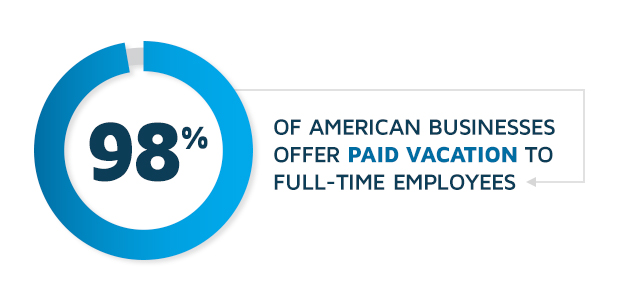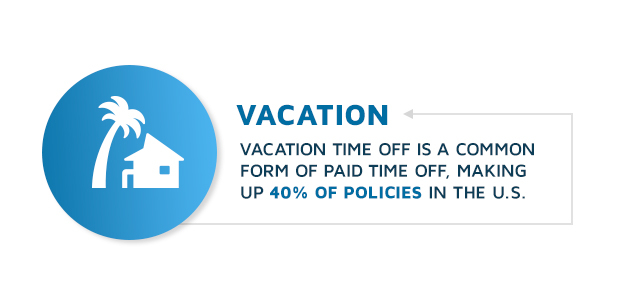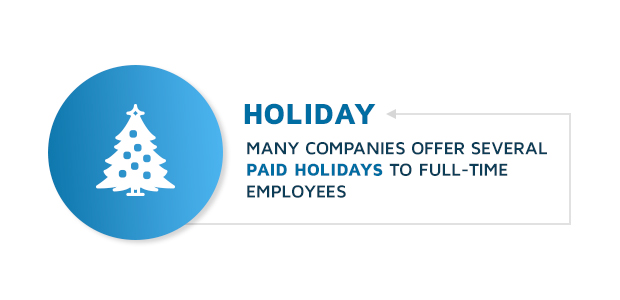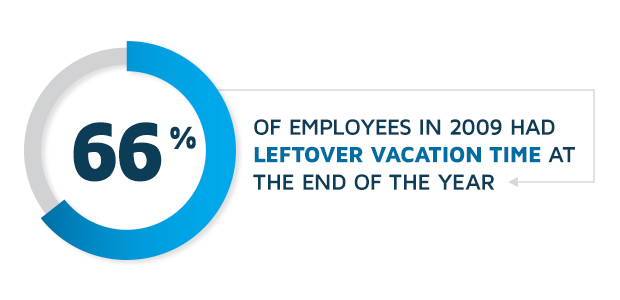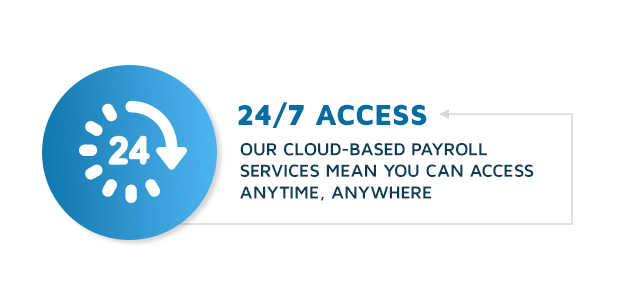Running a small business, while it has numerous perks, can be exhausting. From managing employees to balancing expenses, the daily life of a small business owner is busy to say the least. On top of all this, managers must also handle payroll for employees, and set time-off policies.
Today, 98 percent of American businesses offered some sort of paid vacation to full-time employees, and the average worker gets 15 paid days off. This varies widely based upon the nature and size of the business and the type of time-off offered. However, determining the right kind and amount of time-off for your business can be incredibly difficult, not to mention tracking and enforcing it!
To help you understand the types of time-off in use today, what each system has to offer and how to decide what your policy should be, we’ve created a comprehensive guide to time-off policies.
Types of Time-Off
There are two main types of time-off policies: traditional time off and paid time off, or PTO. In traditional time-off, days off are separated according to their purpose. The types of days off typically include vacation days, holidays and sick days:
- Vacation: Vacation time off is the second most common form of paid time off, making up 40% of policies in the United States. In this program, employees are allotted a specific number of vacation days per year, with the number of days based on the length of the individual’s employment. On average, employees with a company less than a year received eight days of paid time off for vacation, while an individual working with the company for over 20 years earned 22.
- Holiday: Many companies offer paid holidays to employees. Nearly all companies offer paid time off on New Year’s Day, Thanksgiving Day and Labor Day, while fewer grant paid days off on Christmas Day, President’s Day and Columbus Day. Hardly any companies offer paid time off for religious holidays outside of Christmas, such as Rosh Hashanah. Individuals observing these holidays are usually required to take paid time off instead.
- Sick Day: Like vacation days, sick days for employees are determined by the number of years they have worked for the company. Employees working for less than a year average seven sick days, while employees working for longer than a year receive nine. Some employers may be more flexible with this policy depending on the circumstances of the employee.
This traditional system for time off has its benefits, and typically results in more days off for the employees. However, the system also tends to be more difficult to track and budget for, as the payroll office must keep track of the purpose for each day. Additionally, this system tends to result in people lying, claiming they have the flu when they’re really taking their kid to the doctor.
To minimize the problem of tracking days and to allow employees more autonomy in the way they spend their days, many companies are switching to a system called Paid Time Off, or PTO:
- Paid Time-Off: Paid time off, or PTO, is now the most commonly offered time-off plan, making up 58 percent of offered plans in the United States. In this plan, employees receive a set number of days, or accrue paid time off for each hour worked. Instead of set sick and vacation days, they can use these paid time-off days for whatever purpose they choose, and tend to average a total of 19 days off per year. Although the employee usually gets fewer paid days off under this system, the way they can use these days are more flexible. Creating a PTO policy also serves an advantage to employers, who don’t need to track separate vacation, holiday and sick days under this system.
There is also the matter of unpaid time off, which comes into effect after an employee depletes all of their earned paid hours:
- Unpaid Leave: In addition to a paid time off policy, you should also create a detailed unpaid time off policy for when those paid hours run out. Often, employers allow employees to take unpaid days for illness or emergencies, or allow employees to take paid days off if it’s planned, such as a planned vacation. Additionally, under the Family and Medical Leave Act, employers are required to offer 12 weeks of unpaid, job-protected leave each year under the 1993 Family Medical Leave Act (FMLA). This generally includes employees caring for a sick family member, people leaving work due to a serious health condition which prevents them from working and individuals caring for a new child by birth, adoption or foster care.
Banked Time vs. Accrued Time
Businesses further categorize time-off according to how it’s accumulated. Whether the system is a traditional or PTO system, there are two primary ways employees earn time:
- Banked Time: A time-off bank awards employees a total number of paid days off at the beginning of the year. While this is a very transparent method, which allows the employees to plan their time off ahead of time, it does have drawbacks. With this system, it’s assumed that a worker will earn back those days of time off during their employment — however, there are cases where employees use up all of their time off in a short period and then leave the company. While uncommon, these cases do occur, and can be relatively costly to the employer.
- Accrued Time: The more common of the two options, accrued time offers several advantages over banked time. Accrued time is awarded as it’s earned, with employees earning a fixed rate of time off hours for every hour worked. This means employees can’t use paid time off they haven’t yet earned. If the employee takes time off before accruing these hours, however, their time off will go unpaid. The primary drawback with this method is an increased reluctance among employees to take sick days, as well as a slower rate of accumulation.
Some businesses use a combination of these two policies, offering a fixed number of days per year and having employees accrue time over the business year. There are also businesses, especially startups in Silicon Valley, who use a system of unlimited paid vacation, with the stipulation that the employee must discuss time off with a manager or supervisor first. These policies are not as common as banked or accrued systems, but are gaining some traction in certain industries like technology.
Strategies for Setting Policy
In order to set a PTO policy for your small business, you need to take stock of your business as a whole. What do you hope to achieve? How much do you want to budget for time off? Make the process a little simpler by taking the next few steps:
- Consider Your Benefits: Paid time off is one factor of an employee’s benefits package, which also includes a 401(k), life insurance and medical insurance. All of these add up to the benefits package, which should be valued between 25 and 40 percent of your employee’s base salary. Consider the insurance and 401(k) plans you are offering, as well as how much you want to budget for employee benefits, before setting a personal time off policy.
- Consider Employee Use: Consider the amount of time employees generally take on an annual basis. Is your industry one where people need mental health days or sick days more frequently? Do you employ parents with frequently sick children? These are all things to consider when setting policy.
- Consider Demographics: Whom do you employ? If you mostly employ younger individuals under the age of 35, they may be more open to flexible time-off policies like PTO, while older individuals will generally prefer fixed vacation and sick days.
- Consider the Competition: The last thing you want is for your employees to leave you for the competitors because they offer better benefits. Be aware of what your competitors offer and do your best to keep up. This is vital for attracting and keeping employees for years to come.
- Continue to Improve: After setting your policy, regularly review it and poll employees on how well it’s working. Are there enough days allotted? Do people feel the policy is fair to everyone? Ask these questions and constantly look for ways to improve to reduce employee dissatisfaction.
What to Keep In Mind While Setting Policy
While the above are some of the most important factors in setting a time off policy, there are still other factors to consider. Some of these factors include:
- Government Regulations: Time off for vacation is not federally enforced, but employees are entitled to unpaid medical leave up to 12 weeks, if necessary, under the Family Medical Leave Act. Additionally, employers must allow any employee time for jury duty, and in Pennsylvania and Maryland employers must provide time off for employees required as witnesses in court proceedings.
- Industry Variations: Does your industry typically put a lot of physical or emotional stress on your employees? Are workplace injuries or diseases common? Typically, industries where this is the case will use a PTO system instead of a traditional system, as it makes it easier for employees to take the time they need for illnesses or mental health. These industries also frequently allow more time off, paid and unpaid, than other industries.
- Notice Policies: Typically, it’s acceptable for employees to give notice at least three days, if not a week, before an absence, except in cases of unexpected illness or emergency. However, your company may want to enforce a cap for the number of days an employee can call in for a same-day absence. You should also set in place expectations and a standard as to what qualifies as an emergency, such as a sick child, automobile accident or medical emergency, and whether you’ll allow paid time off for partial days.
- Policy Enforcement: In 2009, 66% of employees had leftover vacation time at the end of the year. This disuse means you have to consider what to do if an employee’s paid time off is still unused at the end of the business year.
Most companies enforce a “use it or lose it policy,” where the employee forfeits hours unused at the end of the business year. However, some companies treat time off as a form of compensation, which can be reduced but not eliminated. In these companies, time off is allowed to rollover into the next year, either completely or partially. Many of the companies using rollover policies put a cap on the number of hours rolling over into the next year.
- Whom to Include: Is your time off policy only for full-time employees, or will you allow part-timers to get in on it? Most companies only allow full-timers paid time off, while others only allow part-timers to accrue vacation if they have been with the business for a certain amount of time.
The Advantage of a Payroll Provider
If you own a small business, keeping track of all of the intricacies of payroll can be a hassle, especially when it comes to paid time off. However, there is another way to manage your payroll — a payroll service provider. With a payroll service provider, you can have an industry specialist working for you, without hiring your own payroll department! If this sounds like it would suit your business’ needs, look no further than BCM Payroll Services.
Some of the distinct benefits BCM Payroll Services, Inc. can offer you include:
- Choose Your Payroll Services: Choose which aspects of your payroll you want to keep in-house, and which ones you’d prefer to hand off to professionals. You can always add or remove services from your customized plan if you change your mind!
- Know Your Taxes are Handled: As long as your provide us with the information we need, we can make sure your local, state and federal tax payments are made accurately and on time. We can also handle your W-2s and 1099s if you so wish!
- Access Anytime, Anywhere: Our cloud-based payroll services mean you can access your payroll information anywhere there is an internet connection! Process or view your payroll from anywhere, and give your employees 24/7 access to their paystubs and W-2s!
- Save Time: Handling payroll can be complex and time-consuming. Whether you or an employee handles it, payroll can cost you in time and labor, potentially better spent elsewhere. By outsourcing your payroll to a dedicated payroll provider, you not only save time, you save money!
BCM Payroll Services, Inc. is a premier payroll service company, small enough to pay you specialized attention, yet large enough to offer your business the best in payroll support services. We handle all of your payroll needs, so you can get back to running your business the way you want! Based in south central Pennsylvania, BCM Payroll Services, Inc. offers our all-in-one solution throughout south central Pennsylvania and western Maryland.
Contact us today to find out more about how we can help your business thrive and get a free quote!

